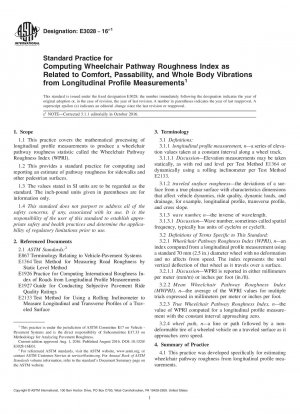ASTM E3028-16e1
Standard Practice for Computing Wheelchair Pathway Roughness Index as Related to Comfort, Passability, and Whole Body Vibrations from Longitudinal Profile Measurements
- Standard No.
- ASTM E3028-16e1
- Release Date
- 2016
- Published By
- American Society for Testing and Materials (ASTM)
- Status
- Replace By
- ASTM E3028-23
- Latest
- ASTM E3028-23
- Scope
5.1 This practice provides a means for obtaining a quantitative estimate of a surface property defined as roughness using longitudinal profile measuring equipment.
5.1.1 The WPRI can be obtained from instruments which can capture high-resolution (described in X1.1.2) longitudinal profiles.
5.1.2 The WPRI is stable with time because true WPRI is based on the concept of a true longitudinal profile, rather than the physical properties of a particular type of instrument.
5.2 When profiles are measured simultaneously for multiple traveled wheel tracks, the MWPRI is a better measure of wheelchair pathway surface roughness than the WPRI for either individual wheel track.
5.3 Wheelchair pathway roughness data can be useful in determining the vibration exposure experienced by a wheelchair user. (See Fig. 1.)
Note 1: The MWPRI scale is identical to the WPRI scale.
5.3.1 Vibration exposure has been linked to pain and injuries in wheelchair users and the WPRI of traveled surfaces provides the ability to quantify the vibration exposure a wheelchair user will experience when traveling that surface.3,4
5.3.2 Knowledge of the vibration exposure a wheelchair will experience on traveled surfaces will allow steps to be taken to minimize their exposure, reducing the likelihood of pain and injury.
1.1 This practice covers the mathematical processing of longitudinal profile measurements to produce a wheelchair pathway roughness statistic called the Wheelchair Pathway Roughness Index (WPRI).
1.2 This provides a standard practice for computing and reporting an estimate of pathway roughness for sidewalks and other pedestrian surfaces.
1.3 The values stated in SI units are to be regarded as the standard. The inch-pound units given in parentheses are for information only.
1.4 This standard does not purport to address all of the safety concerns, if any, associated with its use. It is the responsibility of the user of this standard to establish appropriate safety and health practices and determine the applicability of regulatory limitations prior to use.
ASTM E3028-16e1 Referenced Document
- ASTM E1364 Standard Test Method for Measuring Road Roughness by Static Level Method
- ASTM E1926 Standard Practice for Computing International Roughness Index of Roads from Longitudinal Profile Measurements
- ASTM E1927 Standard Guide for Conducting Subjective Pavement Ride Quality Ratings
- ASTM E2133 Standard Test Method for Using a Rolling Inclinometer to Measure Longitudinal and Transverse Profiles of a Traveled Surface
- ASTM E867 Terminology Relating to Vehicle-Pavement Systems
ASTM E3028-16e1 history
- 2023 ASTM E3028-23 Standard Practice for Computing Wheelchair Pathway Roughness Index as Related to Comfort, Passability, and Whole-Body Vibrations from Longitudinal Profile Measurements
- 2016 ASTM E3028-16e1 Standard Practice for Computing Wheelchair Pathway Roughness Index as Related to Comfort, Passability, and Whole Body Vibrations from Longitudinal Profile Measurements
- 2016 ASTM E3028-16 Standard Practice for Computing Wheelchair Pathway Roughness Index as Related to Comfort, Passability, and Whole Body Vibrations from Longitudinal Profile Measurements
